Blog Category: Angular
How to Select a Good Angular Developer Before Hiring?

A solid understanding of the Angular framework is essential for a good Angular developer. Angular does take time to learn as it is a large framework that consists of different parts and their functionality. To build a feature-rich Angular based web application requires the usage of forms, modules, components, and services. All these elements connect to give you a sophisticated solid structure. So here are a few things that you need to know before getting started on hiring an Angular developer for your applications.
What Is Angular, And What Are The Roles Of An Angular Developer?
Angular is a broad term that denotes all versions post AngularJS or Angular 1. It is a well-refined front-end development platform used predominantly for developing web applications that are responsive and dynamic.
The main activity of Angular developers is to work on the client-side to build a full-fledged and responsive User Interface for websites and web applications. Also, the Angular developer works with the creation of components, modules, and their interconnection.
If high-performance software is what you are looking for, then Angular developers are the best choice. There will also be coordination with the backend developers to make sure that the SPA construction meets with the requirements and other technicalities. Once the development phase is over and then is the testing phase. Angular developers also know about working with APIs and third-party data services.
The Essential Skills To Look For When You Hire Angular Developers:
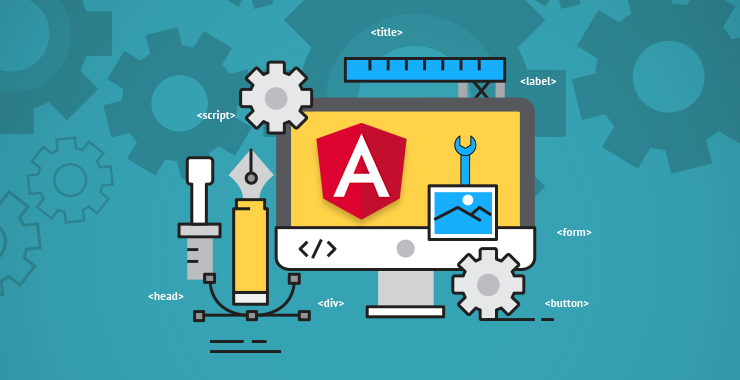
It is always a challenging endeavor to hire the right Angular developers who can effectively handle your Angular Web Development. To hire Angular developers, here are a few fundamental skills that can help you while shortlisting.
Well –versed with JavaScript, HTML, and CSS: The candidate should possess the sound knowledge of JavaScript. The developer should also be good at HTML and CSS. A strong understanding of the UI/UX concepts, elements position, and its interaction is necessary.
Master of Angular Framework: Sound knowledge of the Angular framework and experience in working with the same should suffice your requirement. Also, they should be up to date with new versions of the Angular framework as well.
Hands-on Experience with RESTful API: You should hire angular developers well-experienced in REST APIs with the capability to understand the API documentation and its effective application during development.
Knowledge of allied technologies like NodeJS: Technologies such as Node and Webpack, a JavaScript bundler, can include extra features to the Angular framework. It makes the development process both effective and effortless. Knowing these different technologies can be a plus point.
Where to Hire Angular Developers?
If you are refraining from having an in-house team or require the resource for a short-term project, then hiring a dedicated Angular developer may be the best choice. Many web application development companies offer hiring assistance. It is an excellent opportunity as you gain access to resources from a pool of highly experienced and skilled Angular developers.
We, Tops Infosolutions, are a web and mobile application Development Company in USA. We offer development services and also assistance in hiring resources to work on your web application development projects. To know more, get in touch with our experts at: +1 408-400-3737
Angularjs Vs. React – Which Framework Is In Demand And How To Hire The Right Developers For Migration?
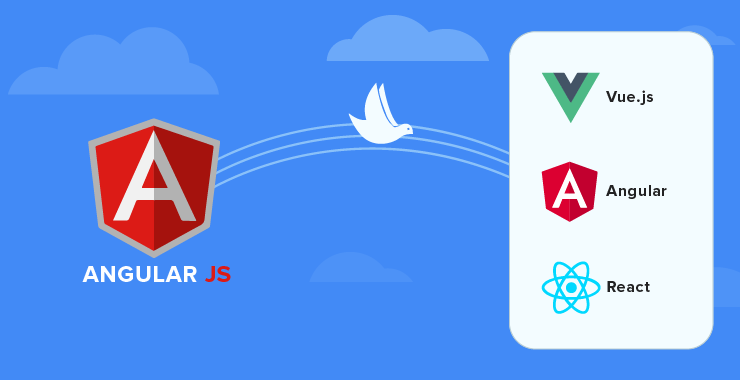
If you are wondering which reliable and robust front-end framework to choose between AngularJS and React, then you have reached the right page. When it comes to front-end development, there are many frameworks available with excellent features. It tends to be trying some times to choose the right one for your project. Both AngularJS and React are JavaScript’s most popular and sought-after frameworks. Developers find them very handy for developing websites and web applications.
Let’s break them apart and analyze which one to go for and will AngularJS to React migration be the solution to your requirement.
AngularJS is open-source based on HTML and JavaScript useful for front-end operations. It is a structural framework maintained by Google for dynamic web application development. It possesses abstraction over code, and hence it proves to be more comfortable for the developers.
Why go for AngularJS?
AngularJS offers many advantages over other JavaScript front-end frameworks. They are as follows.
- Highly Responsive and Scalable
- Provides advantageous and outstanding programming methodology
- Convenient Dependency Injection
- Comprehensive and Speedy Development
- Extremely secure web app development
About React In A Nutshell
React is a strong JavaScript library maintained by Facebook, which is most sought out for building interactive User Interfaces. It is a useful tool for creating front-end UI elements like search bars, buttons, various menus, and many others. The best part for why developers prefer React is that it takes less code and less time during development. Also, it has excellent developer community support.
AngularJS to React Migration
The reasons why developers prefer to migrate from Angular to React are;
- The complexity of Angular is high and challenging to learn, while it is simple with React.
- The virtual DOM manipulation of React is very appealing. It is less susceptible to errors; debugging also is quick and easy.
- Angular is very opinionated and less flexible while working with typically other frameworks. Whereas, React is very much flexible and goes well while working with other JavaScript libraries and frameworks
Given below is the table of significant features of both AngularJs and React JS.
| Angular JS | React JS | |
| Abstraction | Weak | Strong |
| Opinionating | Strong | Weak |
| Learning curve | Steep and difficult | Gentle and quick |
| DOM manipulation | Regular DOM | Virtual DOM |
| Mobile development | Requires third party framework installation | Supports all native mobile app development through React native |
How To Hire React Developers?
When it comes to hiring for your React migration projects, finding the right resource is essential. There are some critical skills that you need to watch out for before hiring ReactJS developers.
Major Skillset:
- Proficiency in Angular and React
- Expertise in Vanilla JavaScript
- Experience with modular programming
- Handled open-source projects
- Experience in migrating projects from Angular to React
We, Tops Infosolutions, are a leading software development company in the USA. We help our clients with the best resource and development support. The hiring process for ReactJS developers is quite simple. Send us your project requirements, which will be followed by a preliminary discussion with our expert. Then you can select the best engagement model for your development and hire the resource. Call us at: +1 408-400-3737 or email contact@topsinfosolutions.com
Angularjs Vs. React – Is The Migration Beneficial?
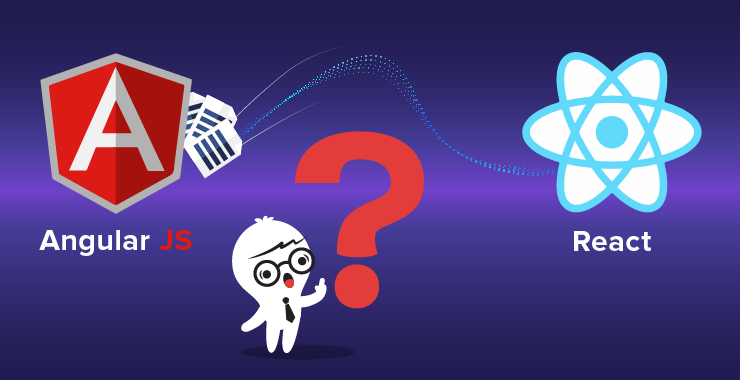
A common problem that most businesses face is that, when they grow bigger and wish to scale up their applications, they’re stuck. With the constant advances in Javascripts and its related frameworks have made it possible to create more improved code writing. Angularjs and react are widely popular in usage in many companies due to their benefits. A requirement that we faced a couple of months ago, our team faced a similar challenge.
The struggle is for real when you to scale up a more extensive User Interface built in Angular. We needed something to upgrade better. Our team came up with React after all the necessary groundwork and brainstorming sessions.
Why go for Angularjs to React migration?



Angular has its own rules to abide by for a developer to work with, whereas React gives the developer the freedom in terms of design and code architecture. React is a javascript library for developing user interfaces and is significantly simple with a quick learning curve. React too enables code reuse, but they operate in unidirectional data binding way. The virtual DOM of React is very engaging and less likely for errors. Debugging is also much more comfortable when compared to Angular, despite its latest updations. React did work out for us. It is much flexible while working with other javascript frameworks, whereas Angular is a bit withdrawn.
The convenience factor and the time-saving aspects of React prove to be beneficial for angular to react migration. React is faster than the AngularJS application. For example, Angular 1 takes almost 5000ms to execute JavaScript code in the browser. But React takes under 1000ms.
How does it benefit?
- A faster framework would take very little time to wait for elements to render in the DOM. Thus you get a quicker, more responsive website. Also, it is SEO friendlier to boot depending on quick page load time. Server-rendering for SEO is essential to get the maximum benefit from React.
- Re-architecting the application with React is possible as it delivers the View of the MVC (Model View Controller framework) model.
- React being backward compatible is another added advantage to the developers.
- React code closely resembles pure JavaScript without JSX. It relies on the principles of functional programming and so the developers can better themselves with the new exposure to stylish code writing.
The migration process takes time, and it is not immediate. The bigger the project, the longer it takes, and that is good. Sometimes, you don’t need to migrate the entire project, and partial transfer also does the job. There are no tools to perform auto migration, but you can hire Angularjs to React migration developers from us. You can take a look at the CV’s of skilled professionals before you hire Angular developers. Call us to know more: +91-7575000269
Why developers opt for React to Angularjs migration?


With recent trends in technology, Javascript is ruling the development category. From web applications to mobile, javascript has made its mark as the most preferred language in Github. It is not only used for front end development but also backend, application developments, and even AI-based applications. The problem always arises when there are too many cooks. It spoils the broth. There are so many libraries and Javascript frameworks to break your head around before you choose the right one for the application that you are developing.
Two other paradigms determine how active your development can be. They are Single page application (SPA) and Multi-page Application (MPA). Single-page applications are more comfortable to develop and do not exhibit many problems when it comes to reloading time. But whereas MP requires data via ajax and does take reloading time, which is quite complicated. There’s another case where a mix of both is required depending upon the requirement.
The new scenario is the angularjs to react migration. Angular can render content from the client-side, but it isn’t very easy to index the content through search bots. This back draw is a serious matter of concern for SEO. So, to develop an app that is an easy and intuitive interface for the user, angularjs posses certain complex situations and compatibility issues. The MVC of angularjs is a simple flow. Controller to Model. Model to view and vice versa. In the case of a web app, where there are too many models and views, the command flow becomes way too much, causing an unidentifiable situation for any infinite command links. The learning curve of Angular is quite steep, hence debugging can give you a tough time.
When compared to Angularjs, React is more compatible. It works with components, and it is simple to import.
Fetch data with: require (‘my component’)
It is so far the best javascript library for user interface building. React, on the other hand, has a reasonably straightforward API.
Create an element with: React.createClass() and
render it on the page with: React.renderComponent(), simple as that.
Built by Facebook, ReactJs is open source and provides the best client and server-side rendering with unidirectional data flow. React js has to be combined with other applications like Flux to work because it is not a framework. So Flux captures the action that comes in and stores it. When the store is saved, view executes again. The best advantage here is that the dispatcher never allows another action to commence before the action from the previous effect is saved.
Due to its significant elements, angularjs to react migration is quite in trend. But why migrate to react?
- Internalized control
- Lightweight components and simple API
- Fits well to component-based User Interface
- Develop components with JSX (own syntax)
- Unidirectional data flow made possible with Flux
- Exchange blocks with ease
- Pre-rendering applications thereby enhancing SEO
- Large forum of React community members for support
- View and controller are present in one place
Unit testing and debugging has become so much easier to react. Highly modular, reusable components, and so much time is saved in the development process. In short, you can get a week’s work done in a day. Thus angularjs to react migration is preferred by developers.
Tops Infosolutions provides entire migration assistance or creating a new application. You can also hire Angular developers from us to get the job done. Call us with your requirements and get a free quote in 24 hours. For more information or guidance, dial:+1 408-400-3737
Migrating from AngularJS: A Day at Our ReactJS Control Room


Writing about ReactJS at my organization makes me curious to look into the daily workings of our React.js team. I pressed the idea to some of my teammates with little skepticism, who got the validation from the team lead. The lead passed the request to the management and voila I received an invitation the next day.
Breaking Down the Agenda
The invitation was from Team Alpha or our go-to team for any sort of React development. The invitation email had all the details about the project and agenda of the day.


Team Alpha includes a number of React veterans, everyday web developers, and erstwhile AngularJS developers. Evidently, they are the first in line to adopt a project that has the word “AngularJS” and “migration” in the scope. Luckily, they had adopted a new project on the day. A team meeting was called and I was on the invitation list.
The blog is my attempt to showcase how we, at TOPS, approach technology migrations, particularly AngularJS to ReactJS migrations. It is the result of spending a day with the leading ReactJS development team at TOPS and many more following meetings. Before discussing the day, let me give you a brief about the project.
The Project: Origin and Broken Trust in AngularJS
When I say they adopted a new project, I did not mean ‘new’ in the strictest form. The project I am talking about was an AngularJS application. The same old story: Google is pulling the plug off AngularJS and businesses with interests in AngularJS are keenly looking for new home for their application.


The application we were supposed to migrate from AngularJS to ReactJS was a part of an enterprise suite. It was an employee-centric application and created 8 years ago. The employee portal was client’s first interest into AngularJS and JavaScript realm. The whole prospects of single page applications made the client excited while their management was already drawn to the hype. A little push from a consulting firm and they built an innovative web experience for their employees.
A Smooth and Focused Transition and a Funny Client Call
Application migrations often mean rewriting the entire application from scratch. At the meeting, nobody wanted to spend months rewriting the entire codebase in ReactJS. We had a fun argument with the client and somehow we convinced him otherwise. At TOPS, we have a strong client-centric culture and we didn’t want to slow down too much on our mission. Additionally, it is a high risk to rewrite everything about an app without testing the water.


It was decided each week Alpha Team would meet for a developer exchange meeting at a conference room, where they will share learnings, brainstorm ideas, but also take larger undertakings. We discussed and decided on the idea for the migration strategy and allocated a sub team of erstwhile AngularJS developers to develop and present the migration strategy.
Redefining the Migration Strategy: Technicalities and Logics
A frontend application is actually a set of HTML documents featuring an edifice of nested HTML elements. Likewise, modern web applications trend to feature an edifice of nested components. A streamlined replica of an application showing a list of comments from employees may look like that:
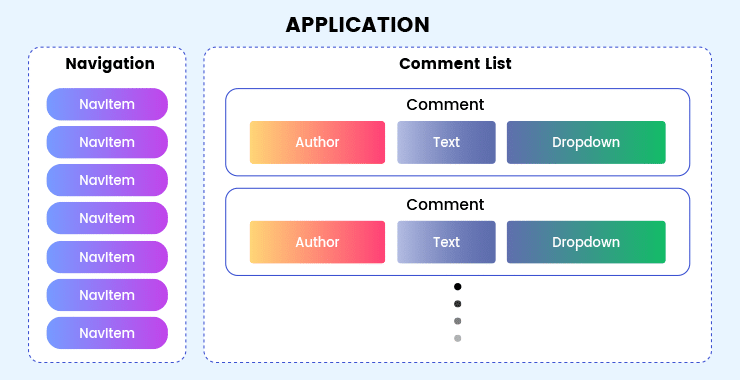

The analogous component tree looks like this:
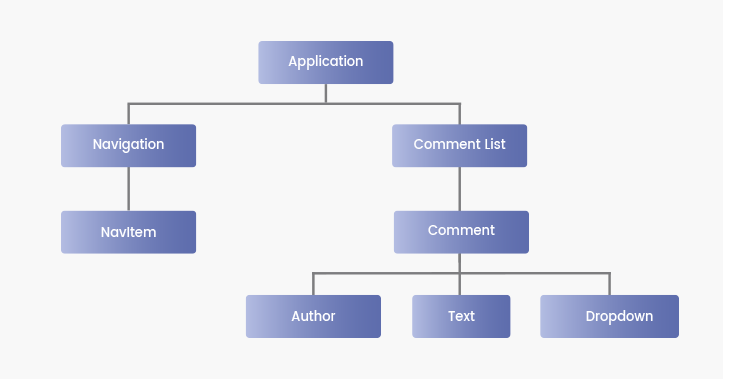

After deciding the migration strategy, the rest of the day passed contemplating complexity replacing and rewriting this tree. This step got a little technical. I will try to explain in as approachable terms as possible but…
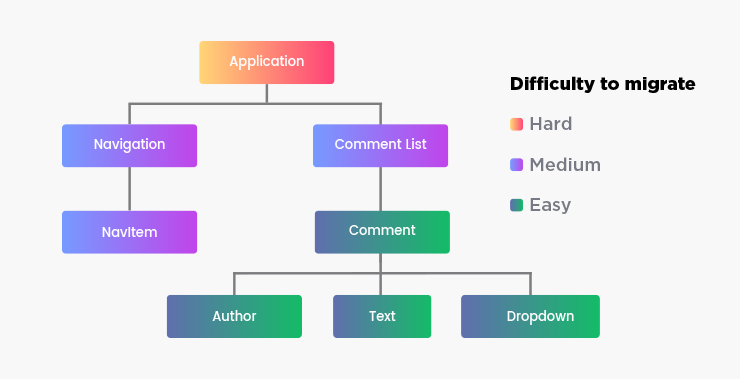

The main Application component is wired up with complex logic like routing. The routing is deeply integrated with the main components and a key piece of AngularJS. NavItem is friendlier. It displays a link, has some trivial logic like “am I ready” and displays anchor text.
The content part of our app contains sub tree showing a list of comments. The ComponentList is complex, as it is attached to the data layer and may retain state: what item is selected etc. The Comment is the easiest part of that tree. It essentially renders a Comment and handles user interaction. The Text component for example is responsible for rendering the text. That component will render in another technology without hiccups
Our conclusion was this that the more you advance down the component tree, the easier it becomes to swap components. For the remaining time, we established the guidelines and looked at elements for that migration strategy. Here are some of the highlights.
Key Guidelines to Migration
- What about new features?
We decided we will built new features in ReactJS & Redux.
- What about existing code?
If possible start to migrate leaf-first up to a whole component tree until you hit the routing module. If you touch old code/ components, estimate how much it would cost to rewrite it, if less than 30 minutes, rewrite, and else get a second opinion.
- What is the simplest way to migrate common UI components?
The rudimentary building blocks of a web app are standard, reusable UI components, like Drop downs, Buttons, Forms etc. They are essential to build new components with React.
Re-write generic UI components when you need them, and let other devs know that they now exist. Use that chance to improve the design/ UX.
AngularJS to React Migration: Upgrade Your Interiors!


Prologue
AngularJS was a decent framework when you wanted to get an MVP live in no time although enforcing a robust architecture or securing great performance, AngularJS was never the first choice. The announcement of Angular as backward incompatible, complete rewrite of AngularJS killed the prospects of the framework and ruined the ecosystem around it. We realized AngularJS doesn’t deserve our time, efforts and money anymore; React was looking promising though.
Migrations: An Untold Story
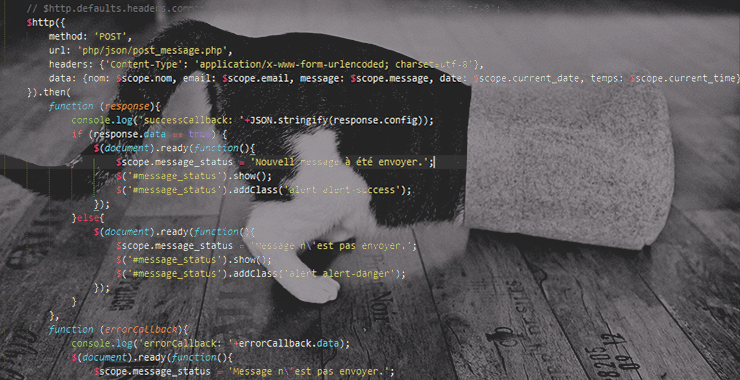

Migrations are tricky whether it is moving from one home to another, one web browser to another or one development technology to another. Ideally, migrations should not happen but in our pursuit to move forward, we tend to abandon things that are not moving fast enough. Your home will start showing signs in 25 years and your car in five years. Internet Explorer went fine for more than two decades and is still in maintenance mode. Maintenance mode is a code in software world to indicate migration.
It’s when you receive a notice from your landlord to empty the apartment in 60 days. You got to find yourself a new home sooner or later. We were in the same situation with an AngularJS application. The client had made his mind halfway towards migration. A little push and he was ready to React!
React for the Unreactive
React, Ember and Angular were the three options when we made our mind to make the migration. Angular was still in beta and not ready for production and, of course, “Fool me once, shame on you. Fool me twice, shame on me.”
Ember is a fine framework for most of the people. Ember touches spots where data-bindings, caching layers between various components and program flow gets a little sloppy. We did not want that to happen again. The whole concept where the entire UI is a clear tree and data flows top down from an immutable data store was a dream come true for us. I mean who doesn’t want their web applications to have this predictable architecture.
Developing applications in React is like setting up water pipeline in an apartment building. The water flows downwards from overhead tank down to the apartments below. Ask a plumber to develop a system of pipelines where water can move either ways. He won’t show up the next day—I am not a magician. Now you know why developers have embraced angularjs to react migration with open arms.
Fixing the Migration Approach
You are a proud Chevy owner and want to stick with a 1930 model as long as you will drive. However, one that you have is not up for your daily commute. You cannot do much because that is the only car that you have and you’re committed to it. You visited a renowned car modification expert in your neighborhood and he agrees to upgrade your car with a fresh coat of paint and 21st century mechanical and electric parts while you can still take it on a drive every evening.
If you’re a mechanic with unlimited budget, then creating a replica is less risky since the client is a little paranoid about his car and may freak out if it stops working during his daily drives.


In real world scenarios, this is how you approach migrations, automobiles or web technologies. This was our plan until… We will build an application clone in React and replace it with the AngularJS application one day. This is how migrations are done or is there another way? If I tell you that you can keep riding your car as you were and I will replace one car component every day until you have a new car. Sounds ridiculous? I thought so too then I realized this makes more sense in the context of software engineering than automobile engineering. A few “Google searches” later, we were fixated on this gradual approach.
Of course, many more factors influenced our choice. AngularJS was an incredible tool to setup MVPs and most of the applications were in a perpetual development cycle. Our scrum-masters decimated the idea of a rewrite. We had to integrate six features into the application in the next six months. A parallel, non-gradual approach meant we had to code the exact, to-be-integrated features in React as well as, god forbid, AngularJS. Some of the features we were adding were beyond the scope of AngularJS or were too much work. We could code the same feature in React in a matter of weeks. React is perfect ;).
Prerequisites
The application was still in AngularJS 1.2 as we were more interested in a migration than upgradation. The attempts to get rid of AngularJS finally and the legacy code was not of much help. In fact, the legacy code made the simple upgradation to AngularJS 1.5 a headache.
You will be shocked to learn we were hardcoded to Bower & Gulp. I repeat Gulp and Bower. You reach a stage in AngularJS development that you start improvising to survive. We reached that stage while developing the app a long time ago and after that, it was all playing with fire. We did not made the upgrade to npm and Webpack because it might break the entire application and we have to revert to the earlier version eventually. Now we have to make the upgrade one last time and we would do it with a smiling face.
AngularJS to React Migration – Key Points
The first thing you will notice while migrating AngularJS application to ReactJS is Components. Components are the building blocks of ReactJS; they are everywhere. AngularJS has directives and they are similar. You could switch the view layer from Angular style templates to React style components and things should turn out fine in most cases as long as you’re using one of those style guides, stick to yours and do not improvise. This is neither AngularJS nor will not turn out to be. You got to start on a solid foundation for your application. Converting Angular directives to React Components was facilitated by a JS library react2angular.



While the 3rd party library made the conversion approachable. We still had to pass them to Redux store. Yes, React + Redux is the industry standard when building React application. When building a new React application, you wrap the root components into Provider. In our approach, where we essentially adding new features in React to an AngularJS application, we had no options but to manually wrap each component with a provider. We were literally copy-pasting code, component after components although ng-redux made the job a little easier.
After a couple of months into making the essential parts work, we were on the last part—setting up routing paths for the newly development parts of the application in React. We wanted to be ready for production as soon as possible. To make things a little more faster and efficient, we wrapped the React component in an AngularJS component and routed it to an inline-template that employs the AngularJS component. react2angular was the reason we could complete the project faster and before the client expected.
Epilogue
When your approach is gradual migration, things get a little complicated. Of course, changing engine in a moving car is more difficult than in one parked in the garage. On top of that, you have to add new features as well replace the existing ones at the same time. Of course, this saves you from rewriting the same code in two different technologies. Nevertheless, making changes in the codebase of a live application is not very different from playing with fire. Gradual approach is indeed not the ideal way to face the migration.
A parallel rewrite makes more sense from both development and business point of view. It is more of a luxury and necessity. As I said technology migrations are not straightforward, sometimes to make things work and make business sense, you have to pick the unconventional way. Who cares as long as the car takes you to the workplace and back?
FAQs
- 1. Is React better than AngularJS?
- Choosing the right framework for a new application or website is essential for any business. Although both technologies are powerful and flexible, ReactJS offers better flexibility and facilitates customization.
- 2. Does AngularJS to React Migration actually help?
- ReactJS has flexible architecture and offers greater control to developers. The applications are faster to develop, predictable, and easy to maintain. This is why the migration from AngularJS to ReactJS can help your business.
- 3. What are the prerequisites for AngularJS to ReactJS Migration?
- A strong foundation is the most important requirement for migration. This is possible with the help of experienced experts with TOPS Infosolutions. We can plan and schedule a parallel rewrite to make things less complicated and manageable.
- 4. How to make AngularJS to React Migration easy?
- If you want to migrate from AngularJS to ReactJS, all you have to do is hire angularjs to react migration developer with TOPS Infosolutions! We have the expertise to answer all your AngularJS-ReactJS migration questions and help make the transition easy and hassle-free.
hire angularjs to react migration | angularjs to react migration
Is ReactJS Better Than AngularJS? Should I Make The Migration?



In June 2018, AngularJS entered 3 years’ maintenance mode. Post the maintenance mode, your AngularJS application will be exposed to potential security threats and would have no safeguard from zero day vulnerabilities. Neither Google nor the AngularJS community has releases an upgrade documentation and chances are they will never. The community and Google’s attention has moved elsewhere and you should too. It is high time you should make a strategic migration to a newer, supported technology such as ReactJS.
ReactJS is Better
ReactJS is the dark horse of JavaScript development and is gaining traction lately. For many stuck with an AngularJS application, ReactJS is the obvious choice. Let’s see what ReactJS brings to JavaScript table and how is it better than AngularJS.
-
Community
ReactJS is backed by a community lead by Facebook developers. With Google, diverting its attention to Angular, AngularJS’s community is shrinking or moving elsewhere. Of course, nobody wants to board a sinking ship, and those who do tend to rush for the nearest exit. The captain might stay for a while to overlook the rescue work and ensure everybody is safe and aboard the rescue ship. Eventually, everybody abandons the ship and look for alternative.


Google is extending the support for the JavaScript framework till 2021 for the same reason. It wants to give you enough time to make the switch. Do you want to board the sinking ship?
-
Architecture
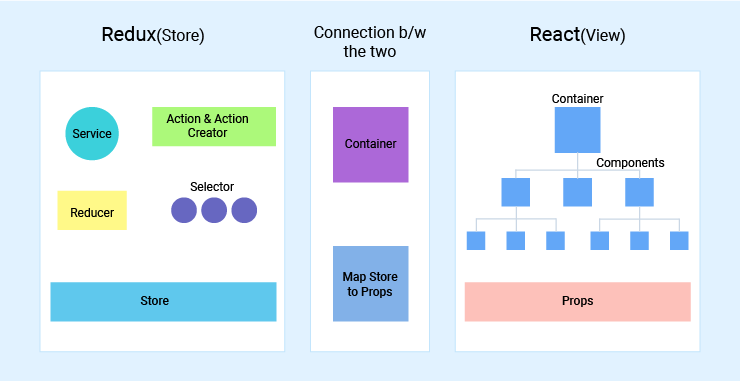

While AngularJS is a full-fledged MVC framework, ReactJS is mere a JavaScript library. You may be like why would I move from a superior MVC framework to just a JavaScript library. An MVC or model-view-controller framework is actually a combination of various libraries.
Think of an MVC framework as Burger King. You visit the store, tell your order to the cashier, the cashier repeats your order to the kitchen staff, the kitchen staff prepares the order and pass it to you. Here the burger you ordered is view, cashier is controller, the kitchen staff is model, and you are user.
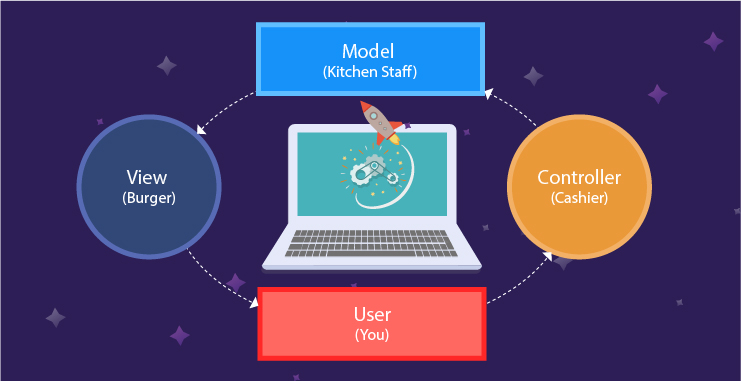

React is mere a ‘View’ library. It needs model and controller if you want to order burgers. You need controller or cashier to gather your info and send an order back to be resolved and model to prepare the view or burger from the information received from the controller.
But sooner or later you are gonna get over with Burger King and look elsewhere. One fine day you realized cashier is too stubborn to take your order requests and now you want cheese sauce in your burger. Clearly, Burger King won’t change the cashier or provision cheese sauce just for you. This is a problem with MVC frameworks. They are bounded by strict set of rule, making way for application with limited customization.
A ‘View’ library like React is like street food, you get what you want, the way you want it. If you’re after customization, in React, sky is the limit with so many ways to do the same thing. Did I mention React is way faster than AngularJS? I mean faster applications with boundless customization, what else were you looking for?
AngularJS enforces a set of coding rule that developers must stick to. In ReactJS, you make your own rules.
-
Rendering
AngularJS applications developed in traditional web technologies: JavaScript, CSS, and HTML, are rendered like any other website on the client side. ReactJS, however, gives flexibility to its developers to render ReactJS application on the server side over a Node.js server.
When you request your Facebook profile on Chrome browser, a content delivery network (CDN) run by Facebook will route the associated JavaScript, CSS and HTML files to the browser, which the browser renders and displays in a systematic way with Facebook logo and all. The same goes when you request a single page application. However, single page applications (SPAs) don’t bode well with the definition of a traditional dynamic websites. SPAs are loaded at once to a single URL. When you make a request not the entire page but only a part of SPA changes much like mobile apps. Of course, SPAs have too much JavaScript code for a browser to render.
In order to dissociate too much JavaScript rendering from the user browser, JavaScript developers have been insisting on Server-Side Rendering (SSR). In SSR, the JavaScript code of your SPA is rendered on the server, preferably a Node.js server, and returns a pre-rendered page to the browser, which the browser can readily present.
Also, a pre-rendered page is readable by search engines. Search engines have a hard time understanding JavaScript but a pre-rendered page is as good as HTML web page for them.
Server-side rendering not only makes for a better web experience for your users but also makes resulting single page applications (SPAs) SEO friendly.
-
Data Binding
In single page applications, there are parent and child states. So what exactly is a state? If you been using Instagram, it has number of parent states.


Look at the image above, the parent states are home and profile. If you click one of the photos on the home screen, the app will take you to the child state.


Every parent state has a number of child states. If go back to our Model-View-Controller (MVC) analogy in context of AngularJS, any change in the model will reflect in view and vice-a-versa. If the customer changes his mind in midst of his order or view, the kitchen staff (model) has to oblige. Also, if the kitchen staff runs out of an ingredient, the customer has to change his preference. This may create chaos at the Burger King and give the manager nightmare. Customers won’t be happy seeing his burger with no lettuce.
If we go back to the states of single page applications, a change in parent state can change child state and vice-a-versa, which is against the philosophy of single page application which are supposed to look and feel like mobile apps. For example, you don’t expect Instagram home (parent state) to turn purple because you ‘Liked’ a purple-background photo (Child state).
The two-way data binding in AngularJS makes web application states a little too unpredictable. As the application grows in size with too many coexisting states, testing become a lengthy task. Developers have to test the application for so many states. Diagnosing the cause of an unpredictable state and fixing is another nightmare for developers. If you been billing hourly, you can run into serious overheads due elongated test and development runs pre-production.
Fortunately, ReactJS has only downward data binding, only parent states can change child states, not the other way around. One-way data binding makes way for predictable single page applications that are easy to develop and take less development time.
Going back to the analogy, Burger King management introduces a new set of rules to cut the chaos, the customer can change his mind before he receives the order. However, the kitchen staff can’t prepare the sandwich with a missing ingredient. They can rather refuse the order. I mean who likes his burger without lettuce. I might go without cheese.
-
DOM
Virtual DOM was unheard about until ReactJS came around. DOM or Data Object Notification is a reflection of what we see in the browser. Web technologies (HTML, CSS and JavaScript) are rendered in DOM elements to be displayed on a user’s web browser. Until ReactJS came, there was just DOM, not real or virtual.
Virtual DOM is a game changer in the field of web development and is one of the reasons from React popularity. Virtual DOM makes application perform blazing fast. Vue.js, which is the best of AngularJS and ReactJS, omitted DOM in the favor of virtual DOM.


Persistent, extensive DOM manipulations are a known bottleneck to a web application’s performance. DOM has a tree like structure and any change in the upper part of the tree is duplicated in the connected lower branches. Single page applications don’t refresh, they just change the state on a user’s request. Traditional DOM might contain its user experience.
If we go back to the Burger King analogy, kitchen staff prepares the order and hands over you the prepared burger. What if there are interns at the kitchen who are learning the art of burger making. They are gonna make mistakes. They might undercook the patty or forget to add, wait for it, lettuce. Nevertheless, they will create the perfect burger in say 4-5 attempts. This will fill the kitchen with too many burgers. Soon there will be left no room to fill new burgers, halting the operations for a while and slowing down order speed. Soon Burger King made provisions so that completed burgers tagged by the chef and rest will be discarded. Virtual DOM is a set of those provisions, which decides what makes it to the DOM.
Virtual DOM is a layer between the actual DOM and the application. Changes requested by users are first made in the virtual DOM and only the relevant changes are made to reflect in the actual DOM or the user’s browser. So the next time you see any application absorbing DOM manipulations like a boss, think ReactJS.
Making a Migration to ReactJS
Indeed, ReactJS was better than AngularJS to begin with. ReactJS offers greater control to developers owing to its flexible architecture. The applications are faster to develop, predictable, and easy to maintain. AngularJS became the de-facto framework for developing single page application because there weren’t many competing JavaScript technologies then. But things are drastically different from what they were a decade ago when AngularJS came about. With AngularJS on a life support system, you got to migrate your applications. You can either wait and watch or act now. We recommend the latter and your developers should too. It is time to bid the father of JavaScript frameworks a long awaited adieu.
Make the Migration with TOPS Infosolutions
Are you ready to say goodbye or you need more reasons to? We are happy to do another session because sooner or later the migration is inevitable. You are being naïve if you think otherwise. Nevertheless, we are here to answer all your AngularJS-ReactJS migration questions whether you have made up your mind or not.
Migrate from AngularJS to a Newer Technology While Retaining the Backend


If you have been following our blogs for a while, then you know we are a full-stack development company. That is, you come in with an idea and walk out with the app(s). We are an end-to-end solution provider for various industry verticals and work on every aspect of application development from conception to lifecycle support. However, not everyone coming to us has requirements this simple. For example, lately we’ve been hitting too many inquiries from people looking to migrate their application base from AngularJS to a newer technology. With AngularJS entering end of support soon and Google not providing any official upgrade path, there are more question unanswered.
To be frank, migrating an app from one development technology to another even with the same programming language and similar architecture is a complex task and at times requires rewriting the entire code from scratch. Which begs the question, “Do I need to rewrite the backend code too?”. The short answer is a big NO. No, you don’t have to. For the longer answer and little background into ‘why’, keep reading.
Frontend and Backend Frameworks
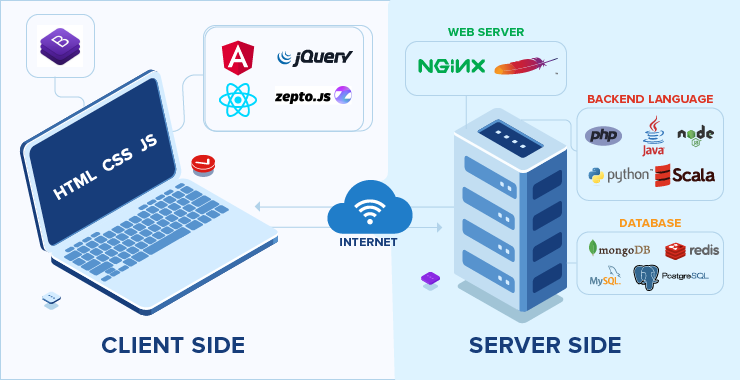

AngularJS is a frontend framework and if you ask us to replace it with a newer technology, as a JavaScript developer, I would be least concerned how your backend looks like. The same goes when it comes to replacing the backend technology. If you are using Laravel, I don’t care whether you’re using React or any other front-end technology. People are coming to us with that kind of question. They are apprehensive about the whole cost involving rewriting backend and frontend. With this blog I am going to clear many misconceptions about the development technology migrations from AngularJS in context of JavaScript realm.
API Calls: How Frontend talks to Backend?
If you’ve been associated with IT operation in any way, you must have heard of APIs a lot lately. APIs let your websites and apps access third party services such NASDAQ, Weather.com, Facebook, Google etc. APIs. If we look at the definition of API, it allows two pieces of software to communicate. Software engineering treats frontend and backend as two pieces of software that builds an application. An API itself is a piece of code which is embedded inside frontend code. The API code has a pointer to the location of backend service on a server, which frontend wants to seek in response to a user’s request over a given protocol. One of the most common protocols over which API calls are made is HTTP(S). Rest APIs or RESTful APIs are the reason for the existence of modern web apps.
REST APIs are the Backbone of Modern Web
When we write a piece of JavaScript code, it has both stateful and stateless parts. For example, AngularJS applications have code specific to AngularJS which other frameworks won’t understand and JavaScript code which is standard across the board.
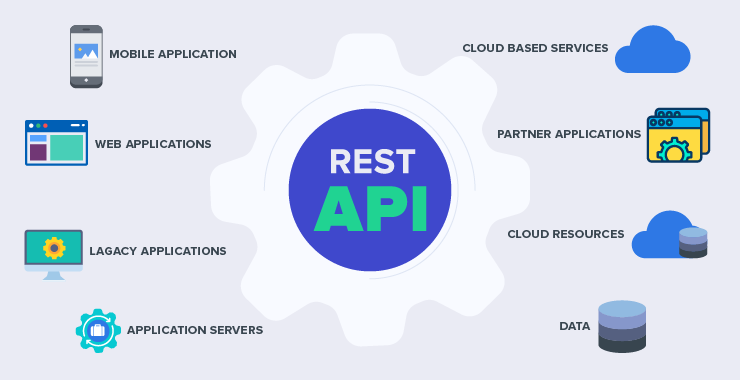

REST APIs are stateless that is they don’t have any dependency on a particular framework or technology. These APIs are good to go as long as they can establish a HTTP connection between the two ends. With REST APIs, it doesn’t matter the backend or frontend since they communicate over stateless REST APIs in HTTP. At least, this is the ideal case.
So when your app or website has to seek a service for example weather information, it can make an API calls to its backend or a third party service like Weather.com. The frontend’s job is to show information to the user, it doesn’t matter where the information came from. But in JavaScript there is more to server technology, than facilitate the communication between the two ends.
Problems: JavaScript, SSR and Non-Node.js Backends
When you are migrating your application from AngularJS to React, Vue.js or Angular or any other frontend framework, you don’t have to worry whether your backend is Node.js or not because ultimately, the frontend is seeking certain services to fulfil users’ requests. Your business logic is smarter enough to trigger right API calls at the right time.
However, when we are talking about JavaScript development tools other than AngularJS such as Vue.js and React, we enter the SSR-dilemma. If you know every modern frontend JavaScript tool has a first class support for server-side rendering (SSR). Developers prefer SSR for improved performance and SEO benefits. For example, while Laravel doesn’t recommend a particular JavaScript or CSS pre-processors, it provides a starting point for using Bootstrap and Vue.js. Until Vue 2.5, it did not support server-side rendering support to non-Node.js environments including those around PHP, Python, Ruby etc.
Vue.js applications require certain Node.js APIs to run correctly. If your application uses those specific APIs, then either the application or the SSR code will break. To bring SSR support in Vue 2.5, Vue.js community made some major changes: including a block that spawns a JavaScript sandbox from the server to generate an output, which made the server renderer “environment agnostic”.
Upgrade your AngularJS Application with TOPS Infosolutions
Long-term support for AngularJS will conclude in mid-2021, which will expose your AngularJS application to security threats and zero-day vulnerabilities, limit its community, and deprive it from modern features. TOPS has the adequate resources to make the necessary measures to upgrade your Angular application while retaining your backend. We have an experienced team of JavaScript developers, which makes the upgradation a hassle-free, smooth transition.
How Angular 7 Improves Development of Progressive Web Apps (PWAs)?


Angular 7 brings many new features to Angular in addition to improving the existing one. The new additions and improvements will make way for developers to build even efficient and better progressive web apps (PWAs). Angular 6 was a great leap in terms of new features and functionalities; Angular 7 is more of an incremental update and fixes various shortcomings to the features introduced to Angular in version 6 and before.
Nevertheless, Angular 7 introduces various new features to Google’s JavaScript framework, which will allow web developers to build web experiences even closer to the look and feel of a mobile app.
Alongside Angular Core, Angular Material has also been upgraded to version 7 and it brings various updated component styles to follow with the new Material Design specifications.
Better PWA Performance
Angular 7 is faster than Angular 6 in terms of getting things done. A quick upgrade (took us less than 10 minutes) to version 7 will bring you a faster framework and a virtual scrolling CDK module, which makes PWAs run with better performance.
Smaller apps and framework have always been the priority of the team at Angular. They realized PWAs were carrying reflect-metadata polyfill in the production stage. Angular 7 removed it.
Also, projects in Angular 7 use Budget Bundles by default and notifies the developer when an app in development exceed size limits: warning at 2MB and error at 5MB. Developers, although, can change the size.
Smaller PWAs with Ivy
You would be like, come on, wasn’t Ivy under development since April 2018? It may have lost the hype it gathered around the time, but it is still going to be an exciting news when it will launch. The last time we heard about. It will enter RC in April 2019 and release with general availability about a month later with version 8.0.
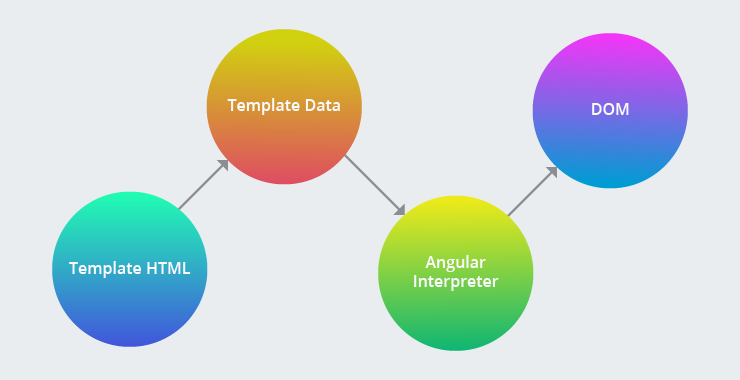

For those who don’t know what Ivy is, Ivy is the upcoming rendering pipeline and view engine for Angular. The highlight of Ivy is how small it makes app. For example, the hello-world app demonstrated with Ivy by Angular Team measured mere 3.2KB on disk space.
So Angular developers, who were complaining about the size of their PWAs approaching that of native apps, will finally have fresh air to breathe. If everything goes as per the plan, Ivy would be an optional view engine for v7 when it will reach mass release and will be the default engine in Angular 8.
Updated Dependencies
Angular upgrades Typescript to version 3.1, RxJS to version 6.3 and also it adds Node 10 support.
Progressive Web Apps – Blurring the Lines between Web and Mobile Apps
Better Scrolling in PWAs
Many frameworks are making a move toward dynamically loading web pages, particularly images and long lists; Angular isn’t any different. Angular 7 takes another leap in this direction with the introduction of ScrollingModule, which allows virtual scrolling. Virtual scrolling is a precursor of virtual DOM present on React. In virtual scrolling, as a user scroll the PWA, the elements of the web app gain or lose visibility. ScrollingModule virtually loads and unloads visible and hidden elements from the DOM respectively as the user continuous to scroll.
Virtual scrolling improves performance of PWAs when scrolling the application. If you are a developer who has to load a potentially large list of items when a user scrolls the application, you can call cdk-virtual-scroll-viewport component and take advantage of the performance boost Angular 7 brings.
Better PWAs with DragDropModule
This is a courtesy of Angular Material 7. Developers don’t have to leave Angular Material and can now remain completely inside Angular Material module and perform drag and drop operation. They can reorder lists and transfer items between lists.
The CDK supports automatic renders, drag handling, drop handling and even the ability to exchange data. And as always if the developer doesn’t live the drag handling, Angular allows him to override the action with a custom one.
Developing PWAs is about to get exciting
The Angular team has steadily focused on refining the gears available to developers and the new CLI prompts ain’t unalike. Typically, when developers throw commands like ng new or ng add to CLI, it’s a one shot. If they forgot to include routing, they can always terminate the command.
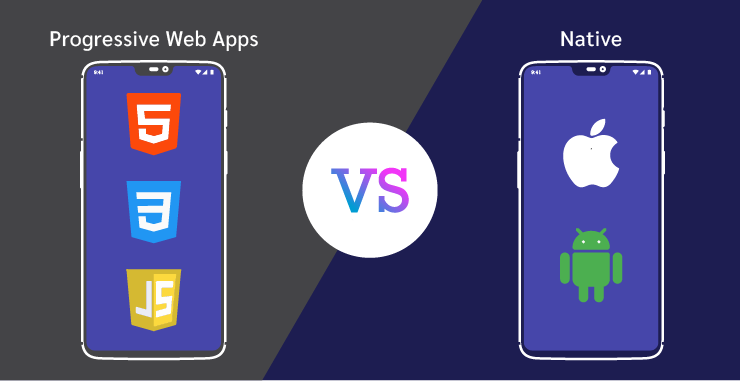

That is not the case with new CLI though. The CLI responds with prompts. Developer can try ng new myangular7app and there is a room for surprise. The brand new prompt asks if they would like add routing or not. If they want to check a dissimilar stylesheet format, the CLI now lets them select between SCSS, CSS, SASS and more. This is a great news, Angular 7 is more customizable than any other version of Angular for developers.
Developers can add a schematic.json with the Schematic CLI. They can tell the Angular CLI which prompts to execute.
Why choose Angular for Web Application Development


Writing long lines of code, testing frequently to find a number of bugs, modifying and updating things every time when something in the app changes, etc. is always a tedious process, consumes much of the time, and results in reduced productivity and unhappy customers.
Hence, to refrain developers from these challenges, JavaScript frameworks came into existence. Although there are many JavaScript frameworks that have their own benefits, Angular is the one that wins the battlefield of web application development.
Angular is a structural JavaScript framework developed by Google that helps developers to simplify the front-end web application development process. It uses HTML as a template language and
extends HTML syntax to express application components in a clear and concise manner. In a short time frame, its release got remarkable applause from developers and enterprises and thus it is being widely adopted today. But, how it helps in developing a remarkable web application?
Here we have listed comprehensive reasons for choosing Angular for your next project….
-
Enhanced Security
Whenever there is any need of modifying data in the existing product or new updates in the technology or any installation is to be made, security is always the point of concern. But, Angular has completely eliminated the fear of data protection as it has the ability to present data in an appealing manner.
Angular uses an HTTP interface to communicate with the server which can be in the form of RESTful APIs or simple web services. The structure of the JavaScript framework is robust and flexible to implement third-party libraries and packages like OAuth. $http module offers CSRF protection but server work is necessary to support this functionality.
-
Creates Applications Quickly with the help of MVC
Another reason to use Angular is, it is based on the MVC model which has made it popular for web development. If you wish to develop dynamic, complex, large, and user-friendly applications, Model-View-Controller is one of the important features.
It divides logic, process, and UI into separate modules and improves the quality of code, removes complexities, and helps developers to build web applications in a hassle-free way.
-
Two-way Data Binding to Develop Web App with Fewer Efforts
A reason why enterprises are embracing Angular for web application development is; it enables them to develop the application quickly with less effort. It supports two-way data binding that helps developers to synchronize the data between model and view components without putting extra effort.
Angular is capable of updating web applications’ front end each time whenever there are any changes in the back end. When data in the model changes, the view reflects the change, and when data in the view changes, the model is updated as well.
Two-way data binding handles the synchronization between the DOM and the model in both ways. Moreover, developers don’t have to write more code at the time of developing web applications and even do not have to write their own MVC pipeline. It offers more flexibility and extensibility when it comes to developing high-end web applications.
-
Real-time Testing of your Web App
By choosing Angular for your next responsive web application with Angular development, developers can efficiently test their app without long waiting periods. Angular provides real-time and built-in test modules, offering precise insights into the already developed components, ensuring an error-free experience.
By running this, developers can save much time as it can work in parallel with the development procedure and also will provide developers with a clear idea about areas where improvements are needed.
-
Creates Reliable Single Page Applications
With this framework, developers can develop fully-responsive single-page applications that can work on different devices and platforms. Angular provides an enhanced user experience along with multiple templates, modules, and UI effects.
Angular provides form validation capabilities, so when a form is used, form controllers write down their states. Moreover, in-built validation of error handling helps to show the error message for the whole form or separate fields.
By using this data, developers can change the behavior of HTML elements used for user interfaces and can also create their own validates if they need. So, if you want to make an attractive and high-performing single-page application, then nothing can be better than Angular.
-
Provides Modularity
Angular helps to create multiple modules for a single application. Each module is dependent on the other module and can be combined further to run complete applications. For instance, developers can use Facebook login modules in several parts of the application such as login, playing games, ordering, etc.
Due to the in-built dependency mechanism, it automatically identifies when an additional module is provided and then binds it to the other developed application modules.
-
Ease of Maintenance
Another advantage of Angular is that it develops applications that are maintainable. Every time when developers develop a web application, they need to go through it over and over again and fix issues and bugs over time.
But Angular can refrain from doing this tedious task. It is because, Angular uses object-oriented design on the client side and helps to remember object–oriented design principles that make web applications easier to maintain.
Wrapping it up…
With so many benefits, it does make sense to use a framework for web app development that offers easy and efficient ways to develop it. Angular provides a win-win situation for developers and enterprises which helps gain popularity in developing interactive, scalable, and efficient web applications.
Planning to choose Angular for your next web development project? Hire expert Angular developers to build a top-notch application over the model-view-controller (MVC) framework.
Get in touch with us today!




